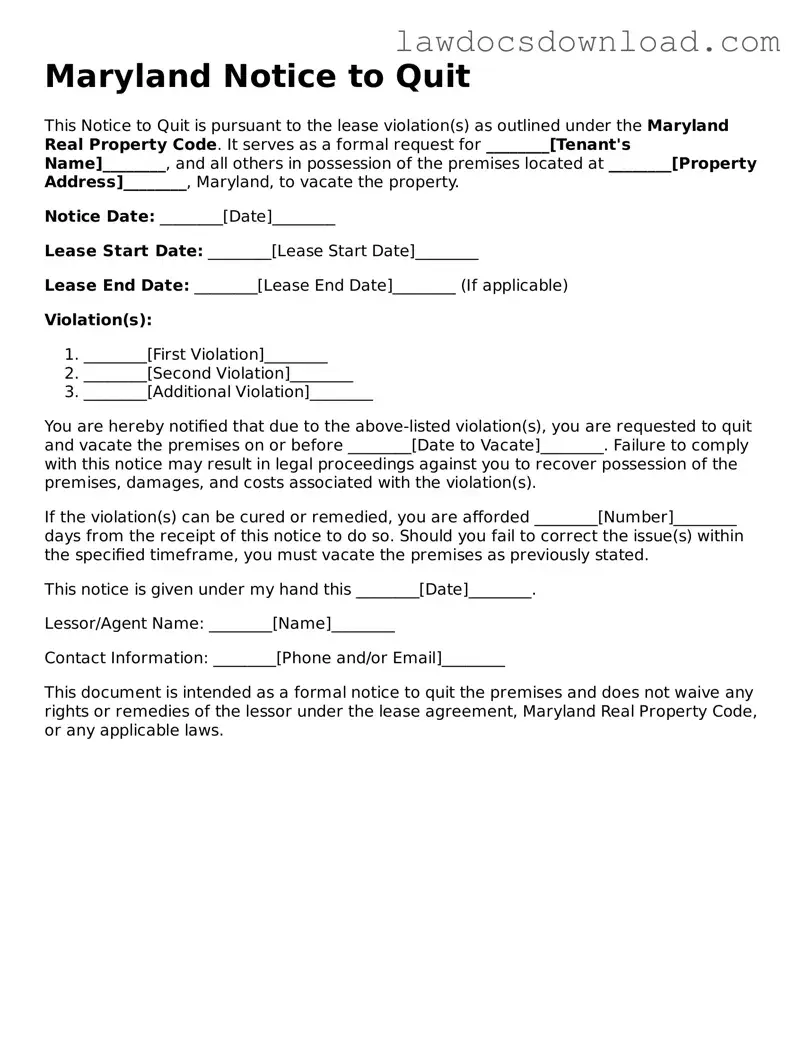The Maryland Notice to Quit form shares similarities with an Eviction Notice, which is used by landlords to inform tenants of an impending eviction due to lease violations, such as non-payment of rent. Both documents serve as an initial step to regain possession of the property, providing a clear deadline by which the tenant must rectify the issue or vacate the premises. The formal structure and legal requirement to give notice ensure both parties are aware of the impending actions and deadlines.
Similar to a Lease Termination Letter, the Maryland Notice to Quit form communicates the end of a rental agreement, albeit under specific circumstances like breaches of lease terms. While a Lease Termination Letter may be used in more amicable situations or mutual agreements to end a lease, the Notice to Quit specifically addresses violations and serves as a precursor to legal actions if not complied with, marking a formal beginning to the termination process under more contentious circumstances.
A Rent Increase Notice is another document that parallels the Maryland Notice to Quit form in its function of notifying tenants about changes to the terms of their rental agreement, specifically regarding rent adjustments. Although serving different purposes—one informing of a lease violation and the other of a rent increase—both documents legally require the landlord to provide tenants with advance notice, thus protecting tenants’ rights and ensuring transparent communication between landlords and tenants.
Payment Demand Letters, used by landlords to formally request overdue rent, share a commonality with the Maryland Notice to Quit form in their purpose of addressing non-compliance with lease terms. Both documents signify formal communication from the landlord to the tenant about a failure to meet agreed terms, starting the process for potential legal action if the tenant fails to respond or rectify the situation within a specified timeframe.
The Unconditional Quit Notice, another variant of eviction-related documents, directly relates to the Maryland Notice to Quit form in its function and severity. This type of notice demands that a tenant vacate the property without an opportunity to correct the violation, used in more severe cases. While the Maryland Notice to Quit often provides a chance for remediation, both documents are used by landlords as a legal means to initiate the eviction process under specific circumstances dictated by state law.
Property Abandonment Notices, which inform tenants that their failure to return within a specified period could result in their possessions being considered abandoned, share the underlying principle of notifying tenants about important actions related to their rental agreement. Similar to the Maryland Notice to Quit, these notices are integral to legal compliance and preserving the rights and responsibilities of both landlords and tenants during the lease period.
A Cure or Quit Notice, closely related to the Maryland Notice to Quit, is specific in its demand for tenants to "cure" (correct) a lease violation within a given timeframe or face eviction. Both notices are employed by landlords to address breaches in lease agreements, yet the cure or quit notice explicitly provides a window for rectification before more severe consequences, such as eviction, are pursued.
The Three-Day Notice to Pay or Quit serves a specific urgency and condition similar to the Maryland Notice to Quit, targeting situations where immediate action is required from the tenant, like overdue rent. This document, offering a short three-day period for compliance, emphasizes the immediacy and seriousness of the situation, akin to the Notice to Quit's role in the eviction process, necessitating prompt compliance to avoid further legal action.
Lastly, the Entry Notice, while generally used by landlords to inform tenants of plans to enter the property for inspections or repairs, shares the procedural characteristic of giving advance notice to tenants akin to the Maryland Notice to Quit form. Although the reasons and outcomes of these notices differ, both are grounded in the legal requirement to inform and respect tenants' rights and space, promoting a transparent and respectful landlord-tenant relationship.
